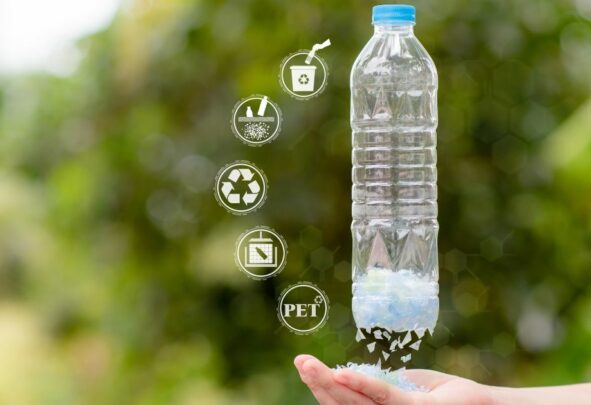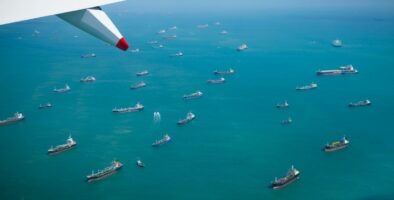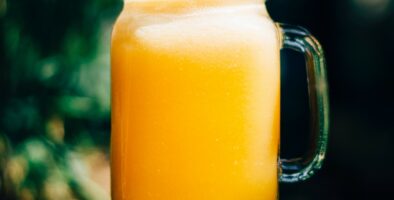Consumers understandably want more environmentally conscious products and a big part of that is in how the products are packaged. PET is an industry favourite for being strong yet light, inert, moisture resistant, and transparent. More recently, PET is also being favoured for being an easy plastic to reprocess. Recycled PET (rPET) is produced by putting PET through a series of chemical processes that can be costly. The cost of production is one of the factors that makes recycled PET a more expensive option than virgin PET. Yet the real barrier to affordable rPET supply is the limited feedstock and insufficient recycling capacity.
Global rates of recycling
Rates of plastics recycling across the world are increasing overall, with just a few outliers heading in the other direction. Recycling rate refers to the proportion of plastics that are recycled by consumers. Asia has the highest recycling rates followed by Europe. India and South Korea have the highest rates in the region but the country that is ‘the best’ at recycling is Germany. In the US, the PET bottle recycling rate continues to fall. The National Association for PET Container Resources’ (NAPCOR) latest report estimated 26.6% recycling rates for PET bottles in 2020, down from 27.9% in 2019 and 28.9% in 2018. On the flip side, China recycled 31% of its plastic in 2021, and new recycling plants have opened recently in Ghana, South Africa and Tanzania. Plus, investment in UK recycling is steadily increasing, supported by high prices for recycled material and a regulatory environment that incentivises using greater amounts of recycled plastics to manufacture packaging. Processing capacity in China is rising but not as quickly as the industry needs in order to meet rising consumer demand for recycled plastic packaging.
Despite improvements to collection and sorting systems, for example consumers in Germany must correctly separate materials otherwise their recycling will not be collected, most of the world’s recycling plants have limited capacity for producing food grade plastic and some plastics are just hard to recycle. Plus, the traditional chemical recycling of PET, and many other plastics, can lead to downcycling, which is when the plastic loses some of its quality after recycling and is therefore not fit for containing food. Independent Commodities Intelligence Services (ICIS) reported in 2021 that food-grade resins are only 10% of the global annual capacity of recycled polymer fit, meaning 10% of the recycling technologies available in 2021 were capable of producing recycled polymers fit for food packaging. This limitation makes collecting and recycling less economically viable but now there is a new take on chemical recycling called ‘feedstock recycling’ aims to avoid this issue and is being rolled out at industrial scale in Scotland and Germany so far.
Losing potential feedstock
rPET production is low and demand is high because it’s not just food and beverage producers that are vying for rPET supply – it is textile producers too. In April 2022, European prices for recycled plastic material reached a record high because of the competition for limited volumes from different types of buyers. Since PET is a polyester, it is good feedstock for clothes made from recycled plastic. Approximately 60% of the garments sold today contain polyester. Earlier in 2022, Continental announced that it had produced a tire made from recycled PET. According to the company, it uses around 400g of polyester fibre per tire. Given that Continental produces more than 142 million passenger car tyres per year, with a corporate goal to use only sustainable materials by 2050, this would represent demand of around 570k tonnes per year of polyester fibre – a huge potential loss from the global bottling pool.
New post-consumer resin collection and processing strategies
Some companies are introducing refill schemes because of the supply shortage. For example, Dutch retailer Jumbo is set to introduce a voluntary deposit on all own-brand juice and smoothie bottles. Meanwhile Dutch Railways (NS) announced plans to install 17 plastic bottle deposit machines across five stations in Amsterdam, Rotterdam, the Hague, Utrecht, and Eindhoven by September 2022. In a bid to reach zero waste at station, the NS hopes the new machines could collect up to 10 million bottles from train passengers.
As new collection strategies are emerging so are the technologies for producing clear recycled plastic. One of the challenges with producing rPET for food packaging is achieving clarity. Many producers of packaged foods need transparent plastic, not just for branding, but to meet consumers expectations (people tend to like seeing what they are buying). Now the number of plastic recycling patents being filed has hit a record high, according to Mathys & Squire, an intellectual property firm. Over 2,149 patents for plastic recycling were filed in 2021, up 7% from the previous year and an eightfold increase since 2016. Mathys & Squire estimates that “Whoever can develop a cost-effective method of producing clear recycled plastic will be able to tap into what some major players estimate to be a potential $120 billion market.” As the race to make clear recycled plastic continues, manufacturers have redesigned their products to make them easier to recycle in the future.
How better product design hopes to increase recycled plastic feedstock
The aesthetic of a product’s packaging can greatly improve consumers’ perception of the product itself, but it can also make it harder to recycle. It is harder to reuse coloured plastic than transparent plastic because coloured plastic can only be turned into something of the same colour whereas transparent plastic can become any colour or remain colourless, again, to sustain the supply of recyclate. With this knowledge, more producers are striving for more colourless packaging.
Since unveiling its new look clear Sprite bottle in 2020, Coca-Cola has placed the new colourless bottle onto shelves in North America , Tanzania, South Africa, Nigeria, Ethiopia, and Kenya. The move makes it much easier to recycle these bottles and with adds value for pickers. This after launching its universal bottle in Latin American markets in 2018, which can be returned or refilled with sparkling and still beverages.
Similarly, UK supermarket chain Waitrose, and Müller UK & Ireland announced that they were scrapping coloured caps on milk bottles in recycling trial. Unlike the current blue, green, and red lids on HDPE milk cartons, the supermarket chain will sell Müller products with clear caps.
What Asia’s rPET boom could mean for global rPET supply?
Most of the post-consumer PET processed in North America and Europe comes from Asian countries, especially China, Taiwan and Indonesia. However, this is going to change in the coming decade as a lot of the countries that supply the feedstock are starting to allow the use of rPET for food grade packaging. In January, the Food Safety and Standards Authority of India (FSSAI) amended India’s Food Safety and Standards (Packaging) Regulations 2018, allowing the use of recycled plastics in food contact materials, with Thailand following in March. More recently Taiwan has issued a proposal to permit recycled PET flakes and chips in food packaging. This rPET boom in the region may spell a further shortage of supply for Europe and North America in the future. More nations in The West will need to improve their collection systems if they are to use domestic feedstock.
What it all means
The main obstacle to affordable food-grade recycled PET is insufficient supply of feedstock, with the underlying reasons being poor recycling rates in several economically developed countries and limited technology for making rPET suitable for food. With new recycling tech potentially emerging in the next few years, the question is if governments and other stakeholders will invest enough for large scale rollouts.
Sources:
BBC News, 2021. How to recycle any plastic. Available at: https://www.bbc.com/future/article/20210510-how-to-recycle-any-plastic
Energy Live News, 2022. Dow and Mura plan Europe’s largest advanced recycling facility in Germany. Available at: https://www.energylivenews.com/2022/09/23/dow-and-mura-plan-europes-largest-advanced-recycling-facility-in-germany/
China Daily, 2022. China’s efforts in recycling of plastic waste paying off. Available at: China’s efforts in recycling of plastic waste paying off – Asia News NetworkAsia News Network
Recycling Today, 2021. Ramp-up in food-grade recycled plastics necessary. Available at: Ramp-up in food-grade recycled plastics necessary – Recycling Today
Czapp, 2022. Plastics and Sustainability Trends in April 2022. Available at:Plastics and Sustainability Trends in April 2022 | Czapp
Czapp, 2022. Plastics and Sustainability Trends in January 2022. Available at: Plastics and Sustainability Trends in January 2022 | Czapp
Czapp, 2022. Plastics and Sustainability Trends in June 2022. Available at: Plastics and Sustainability Trends in June 2022 | Czapp



